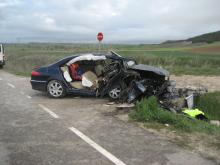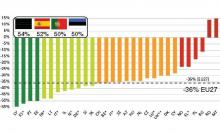The European Transport Safety Commission (ETSC) is hopeful that coming elections will result in a political leadership keen to address European road safety. The ETSC has identified speeding, driving under the influence of alcohol or drugs, infrastructure safety and the safety of vulnerable road users as priority areas for action during the mandate of the next European Parliament. Antonio Avenoso, ETSC executive director said, "Action in all of those areas carries significant potential to prevent deaths and
The 5801 European Transport Safety Commission (ETSC) is hopeful that coming elections will result in a political leadership keen to address European road safety. The ETSC has identified speeding, driving under the influence of alcohol or drugs, infrastructure safety and the safety of vulnerable road users as priority areas for action during the mandate of the next European Parliament. Antonio Avenoso, ETSC executive director said, "Action in all of those areas carries significant potential to prevent deaths and serious injuries on EU roads. ETSC strongly believes future MEPs should support new policies, as well as the extension of existing initiatives, in these areas to address the most significant risk factors on EU roads," said Avenoso.
Successive EU Parliaments, including the outgoing one, have historically been strong road safety advocates. It will be instrumental that current MEP candidates also make road safety a priority for the 2014-2019 mandate. “There is both a moral and a financial imperative for EU decision-makers to strive towards the highest levels of road safety and to reduce intra-EU differences in risk on the roads,” said Avenoso. “The societal savings which can be unlocked through the reduction of the numbers of deaths and injuries are considerable, certainly outweighing the necessary investments to improve road safety,” he added.
Reaching the EU 2020 road safety target will depend in part also on the activities of newly elected MEPs, who must support and fuel the stepping up of efforts to improve road safety, both at the national and EU level. Moreover, reducing the number of road deaths is but part of improving road safety overall. Future MEPs should push the2465 European Commission to follow up on the ‘First Milestone Towards a Serious Injury Strategy’ paper with a detailed roadmap of actions and a target for reducing the number of serious injuries on EU roads. “As deaths and serious injuries are two sides of the same problem, the same level of ambition should be shown in setting a target for both indicators. ETSC has proposed a 35% reduction target for serious injuries over the 2014-2020 period,” said Avenoso.
Successive EU Parliaments, including the outgoing one, have historically been strong road safety advocates. It will be instrumental that current MEP candidates also make road safety a priority for the 2014-2019 mandate. “There is both a moral and a financial imperative for EU decision-makers to strive towards the highest levels of road safety and to reduce intra-EU differences in risk on the roads,” said Avenoso. “The societal savings which can be unlocked through the reduction of the numbers of deaths and injuries are considerable, certainly outweighing the necessary investments to improve road safety,” he added.
Reaching the EU 2020 road safety target will depend in part also on the activities of newly elected MEPs, who must support and fuel the stepping up of efforts to improve road safety, both at the national and EU level. Moreover, reducing the number of road deaths is but part of improving road safety overall. Future MEPs should push the






